| Author |
Message |
J.D. Crawford

|
 Posted: Sun 11 Nov, 2012 7:13 pm Post subject: Hands-on Review: A&A 13th Century ‘D Pommel’ Cavalry Swo Posted: Sun 11 Nov, 2012 7:13 pm Post subject: Hands-on Review: A&A 13th Century ‘D Pommel’ Cavalry Swo |
 |
|
Arms and Armor 13th Century ‘D Pommel’ Cavalry Sword
Introduction
Arms and Armor of Minneapolis MN is a company that hardly needs introduction amongst sword enthusiasts and collectors. As the longest established manufacturer of medieval arms replicas in the USA, they carry a fine line of products and have a solid reputation for both historical accuracy and quality. They are also the go-to people for relatively affordable custom pieces.
The piece in question here was commissioned after this author viewed the following myArmoury thread: http://www.myArmoury.com/talk/viewtopic.php?t=20025 The thread pictures a number of swords with Oakeshott category D pommels, sometimes described as shaped like a ‘cocked hat’ or the roof of a pagoda. Looking at the examples there are several that cluster into a very similar family of single-hand swords with long relatively slender blades and straight crosses. Some of these are quite famous and will be recognized immediately, whereas others are lesser known examples.
Although no two are identical, they are alike enough to indicate a style, if not manufacture by the same workshop or even hands. This led to the notion of designing a similar sword based on some personal preferences, as if placing an order from the historic shop (see next section for details). Since that hypothetical medieval shop has disappeared in the mists of time, I instead e-mailed these specs to Craig Johnson, Production Manager for Arms and Armor. After a few discussions about the details, the project was underway.
Some of the process was documented here: http://www.myArmoury.com/talk/viewtopic.php?t=26665
At some point along the line Craig mentioned the possibility of putting this sword into production (which I approve), so I will treat this as a review of a product prototype.
Overview
This sword is based on specific features selected from the three similar historical swords pictured/linked below. Each of these swords has a similar type D pommel and an Xa/XI blade of about 95cm length. Based on the considerable length and handling characteristics of such blades it is reasonably assumed that these swords were intended for use from horseback. Although Oakeshott dated one of the swords linked below to the 12th century, most experts date these swords to the 13th century and consider them to be German in both manufacture and geographic distribution.
Pommel: http://www.myArmoury.com/talk/files/d_pommel_514.jpg (Note the slight concavity of the underside and the smooth rounded lines of the top)
Cross: http://pic100.picturetrail.com/VOL907/4313045...812709.jpg (a simple type 1, but with nicely rounded cross-section toward the tips rather than the usual square cross-section)
Blade: http://www.myArmoury.com/talk/files/1126_930.jpg (with a relatively short fuller and rounded toward the tip, perhaps denoting a late version of the type).
In addition, I requested a ‘bloody red’ (not oxblood) color for the leather grip –to make it stand out a bit from other swords in my collection.
Measurements and specifications of the modern sword:
Weight: 2 pounds, 15 ounces (1.32 kg)
Overall length: 42.5 inches (108 cm)
Blade length: 35.6 inches (90.3 cm) from cross to tip
Blade width: 1 3/4 inches (4.4 cm) at base, tapering to 7/8 inch (2 cm)
Grip length: 4.6 inches (11.8 cm)
Guard width: 9 inches (22.8 cm)
Point of Balance: 5.5 inches (14 cm) from guard
Center of Percussion: ~22 inches from guard
Oakeshott typology: Type Xa or XI blade (with unusually short fuller), D pommel, type 1 guard with rounded cross-section
Handling Characteristics
I was surprised when I unpacked this sword and took the first few swings inside my home; that long sharp blade started flitting around my living room much more quickly than I expected. This is a sword that (relative to other large single hand swords) is both nimble and precise. The reasons appear to be that for a sword of this type and dimensions 1) the overall weight is relatively low 2) the long handle and large pommel helps to keep the point of balance is relatively close to the cross, and 3) the weight distribution of the blade benefits from its narrow profile and thin tapering blade (I estimate 4.5 mm at base, 4mm halfway down, and 3mm nearer the tip). Still, although it’s hard to put into words, the feel is different than e.g., an XII sword with more weight concentrated near the hand. There is a presence authority to this blade (the short fuller likely contributes to this) but still it’s quite easy to put that sharp edge where you want it in a hurry. The handle feels best in the hammer grip against the cross; one can let the hand slide down and palm the pommel using either hammer or handshake grip, but the pommel edges are too acute to allow easy transitions between these two grips. Putting it through some fencing maneuvers, I felt it would do quite well ‘off the horse’, especially in a one-on-one dueling situation, but would likely be too long to maneuver well in close quarters.
I have not had opportunity to test cut with this sword, but one expects it would be an excellent cutter against light and medium targets as it’s easy to achieve a high velocity, the smooth lenticular cross-section provides ideal geometry, the integral edge is very sharp. However, I don’t think it has the heft to do well at crushing heavy targets. As usual for A&A, the temper is excellent; the thin blade is flexible but relatively stiff and resistant to vibration, even when struck away from the center of percussion. The pivot point is a bit back from the tip, but it’s hot hard accurately aim a thrust. The tip is slightly rounded for tip cuts but is sharp enough to easily penetrate poorly protected targets. But likely the thin blade would buckle against hard targets.
My only criticism of the handling relates to the feel of the grip: although the oval cross-section provides good edge control and the central risers give good adherence for a firm grip, the leather is otherwise quite smooth and feels a bit slippery when a looser grip is used. This could easily be fixed with some additional fine underwrap and/or overwrap impression along the entire grip.
Fit and Finish
I’m a big fan of the way A&A finishes their swords, and this one is no exception. As one would expect, everything is tight and the blade produces the familiar ‘ring’ of A&A products. The lines are all even, crisp, and clean. The pommel is particularly pleasing, including subtleties such as a very slight concavity in the underside toward the hand, something I have not seen on any other modern reproduction of this type. There are some different styles to the finish: If one looks very closely at the blade, one can see a ripple pattern (not grind marks) that bespeak some type of power polishing. The pommel looks hand finished. The cross has a ‘frosty’ finish. Each component looks very nice and they flow together well.
The blade geometry on this sword is a highlight. Unlike some modern reproductions of medieval swords, past the fuller this sword possesses a beautifully smooth and rounded lenticular cross-section (see close up below).
My only critique of the construction is that the cross is rotated slightly about the axis of the blade, presumably this arises from difficulties in forming a true hole for the tang, because one sees this on many swords.
When it first arrived, the grip leather had a lighter orangey-red appearance that did not initially thrill me, but within a few days of handling it darkened (presumably from natural skin oils), taking on exactly the dark bloody red appearance that one can see in the pictures below (i.e., exactly what I wanted). My only critique of the wrap is that the leather was slightly short or shrunk so that if one looks very closely one can glimpse a tiny bit of the wood grip at either end.
In terms of historical accuracy, I feel overall this is a fine effort that comes closer than any other modern replica that I have seen in sword type. However, the sword is not quite so long (by 2” / 5 cm) as the originals it is based on. This likely benefits the handling properties described above. The shortening seems to arise in the fullered part of the blade, making the fuller seem relatively short (almost like a narrow XIII). Perhaps the fuller should be lengthened a bit (1-2”) to maintain historical proportion.
Conclusion
With this sword A&A have turned out yet another triumph; a beautiful example of an interesting and under-represented sword type. The finish and level of historical accuracy is excellent (certainly relative to other production replicas of this type), although the blade appears to be slightly smaller and therefore probably easier to handle than the originals that were used as models. As a potential prototype, I have mentioned a few minor details above that might be altered to improve this sword, but I would not hesitate to reccomend this sword, as is, to anyone interested in a long-bladed, single handed medieval sword.
-JDC
 Attachment: 87.67 KB Attachment: 87.67 KB

 Attachment: 155.55 KB Attachment: 155.55 KB
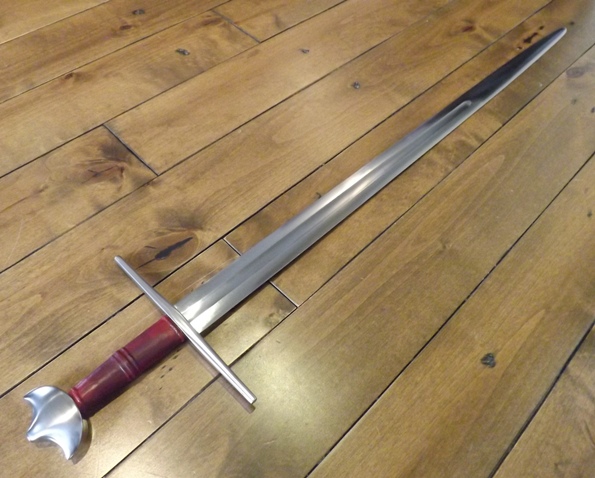
 Attachment: 153.34 KB Attachment: 153.34 KB
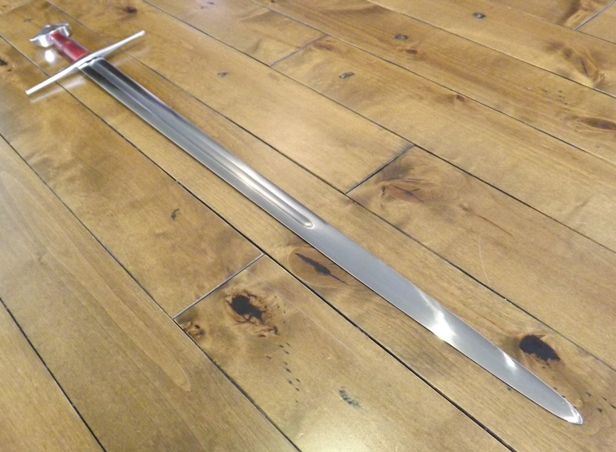
 Attachment: 151.5 KB Attachment: 151.5 KB

 Attachment: 116.92 KB Attachment: 116.92 KB

 Attachment: 156.88 KB Attachment: 156.88 KB
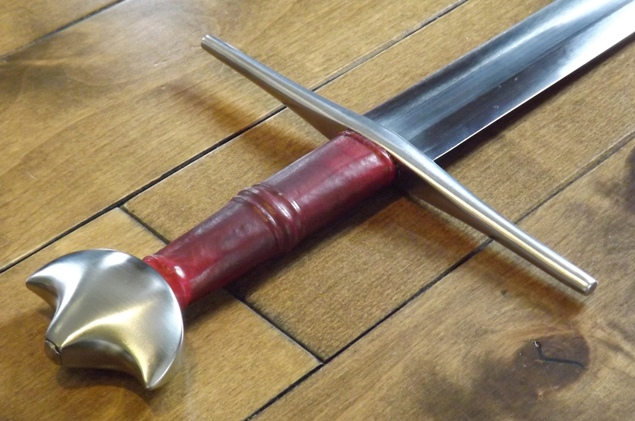
 Attachment: 164.81 KB Attachment: 164.81 KB
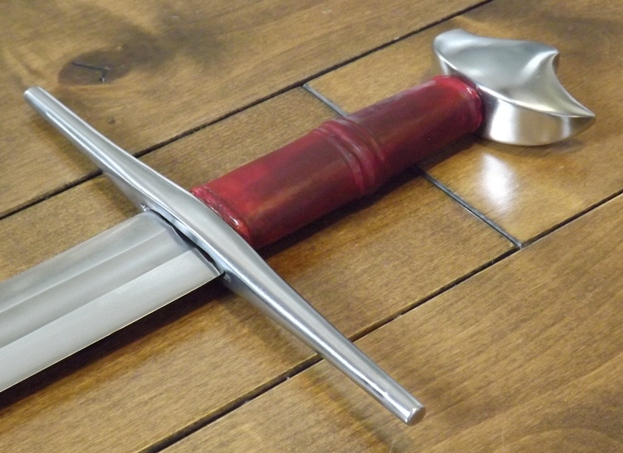
 Attachment: 151.96 KB Attachment: 151.96 KB
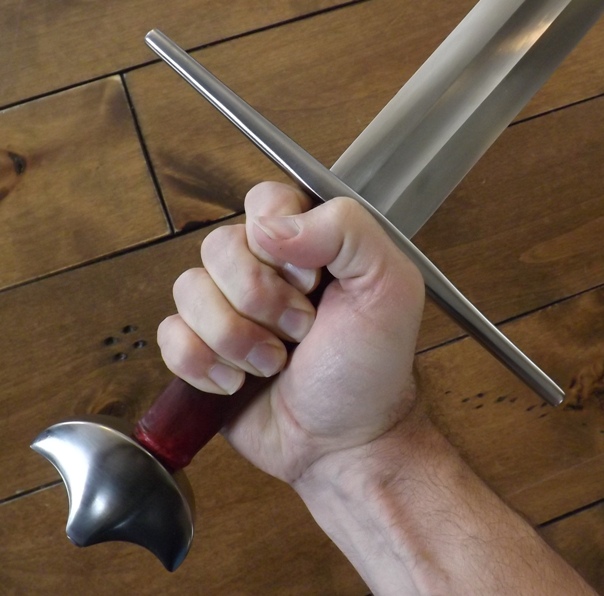
|
|
   |
 |
|
Jeremy V. Krause
|
 Posted: Sun 11 Nov, 2012 8:01 pm Post subject: Posted: Sun 11 Nov, 2012 8:01 pm Post subject: |
 |
|
Thanks for the great review Doug,
This is an excellent addition to your impressive collection.
The red of the grip really ties the whole package together here. The longish grip and type 1 cross give a noble aspect to this fine weapon.
It's hard to see in the pictures but how even/cleanly is the blade slot finished? How do you like the finish on the peen?
Congratulations and I hope to have a chance to handle it soon.
|
|
  |
 |
T. Arndt

|
|
   |
 |
|
Tim Lison
|
 Posted: Sun 11 Nov, 2012 10:13 pm Post subject: Posted: Sun 11 Nov, 2012 10:13 pm Post subject: |
 |
|
|
Looking GREAT JD!!!! I really like what they did with the leather of the grip. The rounded tip of the guard is a feature you don't see in repros too often. Well done and congrats!!!
|
|
  |
 |
William Swiger

|
 Posted: Mon 12 Nov, 2012 12:22 am Post subject: Posted: Mon 12 Nov, 2012 12:22 am Post subject: |
 |
|
|
Outstanding sword. I hope they do make a similar one for production.
|
|
  |
 |
J.D. Crawford

|
 Posted: Mon 12 Nov, 2012 5:24 am Post subject: Posted: Mon 12 Nov, 2012 5:24 am Post subject: |
 |
|
Thanks guys.
Jeremy: the blade slot is quite even on this one. The peen has been left visible, but is nicely polished and looks fine with the pommel.
Tim: you'r right, there's a lot of nice detailing here that you don't see in most reproductions. Too many for me to describe, but as they say, a picture tells a thoushand words.
I really wanted to convey how good it fells in the hand. Surprisingly nimble.
-JD
|
|
   |
 |
Robin Smith

|
 Posted: Mon 12 Nov, 2012 5:24 am Post subject: Posted: Mon 12 Nov, 2012 5:24 am Post subject: |
 |
|
Very cool... I think they did a proper job on the pommel. Cocked hats are more subtle than they appear. This one is a good one....
A furore Normannorum libera nos, Domine
|
|
   |
 |
Craig Peters

|
 Posted: Mon 12 Nov, 2012 6:46 am Post subject: Posted: Mon 12 Nov, 2012 6:46 am Post subject: |
 |
|
One thing I've noticed about this sword and some of the other Arms and Armor custom swords is that the fuller terminates rather abruptly, rather than gradually, as seen on Albions, which I find to be aesthetically more appealing.
My question is, how often do the fullers on historical swords terminate like this reproduction from A&A? Looking at the original thread which was the inspiration for Doug's project, it is difficult to say for certain, but it looked like most of the swords had at least some blend into the blade. I have seen Viking era swords that terminate this sharply, X.8 from Records, shown here from myArmoury, being a classic example.
Can anyone provide me with further information on this topic?
http://www.myArmoury.com/view.html?features/pic_spotx04.jpg
|
|
  |
 |
J.D. Crawford

|
 Posted: Mon 12 Nov, 2012 7:03 am Post subject: Posted: Mon 12 Nov, 2012 7:03 am Post subject: |
 |
|
| Craig Peters wrote: | One thing I've noticed about this sword and some of the other Arms and Armor custom swords is that the fuller terminates rather abruptly, rather than gradually, as seen on Albions, which I find to be aesthetically more appealing.
My question is, how often do the fullers on historical swords terminate like this reproduction from A&A? Looking at the original thread which was the inspiration for Doug's project, it is difficult to say for certain, but it looked like most of the swords had at least some blend into the blade. I have seen Viking era swords that terminate this sharply, X.8 from Records, shown here from myArmoury, being a classic example.
Can anyone provide me with further information on this topic?
http://www.myArmoury.com/view.html?features/pic_spotx04.jpg |
I agree Craig that the historical swords used to inspire this project had a more 'blended' (either tapering away or becoming more shallow) fuller terminal than this reproduction. If one looks at swords from this era in general, then off the top of my head, I would say about 90% had the blended terminal and about 10% ended abruptly. Was this a different style, different production methods, or just different hands making the same type of sword? I don't know. One might argue that the A&A style represents this less common historical type.
I think the nice lenticular cross section near the tip is an important step forward in this sword; a 'fading' fuller could be something else for the guys at A&A to think about.
|
|
   |
 |
Roger Hooper

|
 Posted: Mon 12 Nov, 2012 8:35 am Post subject: Posted: Mon 12 Nov, 2012 8:35 am Post subject: |
 |
|
|
Great review and another great design from A&A of a sword and pommel type that is not often re-created these days.
|
|
  |
 |
|
Patrick De Block
Location: Belgium Joined: 10 Aug 2008
Posts: 84
|
 Posted: Mon 12 Nov, 2012 1:13 pm Post subject: Posted: Mon 12 Nov, 2012 1:13 pm Post subject: |
 |
|
|
Am I right in supposing that there is nearly no distal taper for the length of the fuller since it ends abruptly and the distal taper only really starts at the lenticular section?
|
|
  |
 |
J. Hargis

|
 Posted: Mon 12 Nov, 2012 3:06 pm Post subject: Posted: Mon 12 Nov, 2012 3:06 pm Post subject: |
 |
|
J.D.:
Excellent review and a well thought out commission from A &A. A truly beautiful sword that I too hope will be put into production by A & A.
Heretofore, Albion's Ritter was at the very top of my 'next to purchase' list, I even had a red grip wrap in mind. And IMO, The Ritter is the best D pommel sword currently in production. Seeing your new sweetheart now has me thinking. For comparison sake, here are the numbers for your new A & A and for The Ritter. Should we assume then that these differences were the deciding factor for you?
Thanks, Jon
your A & A:
| Quote: | Weight: 2 pounds, 15 ounces (1.32 kg)
Overall length: 42.5 inches (108 cm)
Blade length: 35.6 inches (90.3 cm) from cross to tip
Blade width: 1 3/4 inches (4.4 cm) at base, tapering to 7/8 inch (2 cm)
Grip length: 4.6 inches (11.8 cm)
Guard width: 9 inches (22.8 cm)
Point of Balance: 5.5 inches (14 cm) from guard
Center of Percussion: ~22 inches from guard
Oakeshott typology: Type Xa or XI blade (with unusually short fuller), D pommel, type 1 guard with rounded cross-section |

Albion's Ritter
| Quote: | Total length: 40.15" (102 cm)
Blade length: 33.75" (86 cm)
Blade width: 1.89" (4.8 cm)
CoG: 5.125" (13 cm)
CoP: 22.75" (58 cm)
Weight: 2.57 lbs (1.17 kilos) |

original influence for The Ritter

A poorly maintained weapon is likely to belong to an unsafe and careless fighter.
|
|
  |
 |
J.D. Crawford

|
 Posted: Mon 12 Nov, 2012 5:29 pm Post subject: Posted: Mon 12 Nov, 2012 5:29 pm Post subject: |
 |
|
| Patrick De Block wrote: | | Am I right in supposing that there is nearly no distal taper for the length of the fuller since it ends abruptly and the distal taper only really starts at the lenticular section? |
I don't have the calipers to take precise measurements, but it looks to me like this blade has a modest linear taper along its entire length, starting at about 4.5mm and ending up around 3mm before it narrows to the tip. The lenticular section is slightly rounded in comparison to the flatter sections on the albions I have owned.
Last edited by J.D. Crawford on Mon 12 Nov, 2012 5:46 pm; edited 1 time in total
|
|
   |
 |
J.D. Crawford

|
 Posted: Mon 12 Nov, 2012 5:45 pm Post subject: Posted: Mon 12 Nov, 2012 5:45 pm Post subject: |
 |
|
| J. Hargis wrote: | J.D.:
Excellent review and a well thought out commission from A &A. A truly beautiful sword that I too hope will be put into production by A & A.
Heretofore, Albion's Ritter was at the very top of my 'next to purchase' list, I even had a red grip wrap in mind. And IMO, The Ritter is the best D pommel sword currently in production. Seeing your new sweetheart now has me thinking. For comparison sake, here are the numbers for your new A & A and for The Ritter. Should we assume then that these differences were the deciding factor for you?
Thanks, Jon
|
I was afraid someone would ask me that!
Well, first off I want to say that the Ritter is also beautiful piece, and by all acounts handles very well. As a replica of the historic sword you show, I would say Albion did a terrific job on the hilt. However, they chose to shorten the blade by a full 4 inches (which also affects the profile of the blade). I suspect they did this to appeal to a wider market, but I was looking for something closer to the originals; a highly specialized sword with a very long reach. I also wanted something a bit different and the rounded spike hilt cross on some of the other historic examples really appealed to me, as well as some of the subtle differences on the pommel I chose.
If someone wanted an exact replica of the piece that inspired the Ritter and the blade on my sword, one should really consider the beautiful silver inlay as well. I came to appreciate inlay more after my last commission from Jeff Helmes. This would make for a wonderful piece, but it would also cost a lot more than either the Ritter or the current piece.
|
|
   |
 |
J. Hargis

|
 Posted: Mon 12 Nov, 2012 8:20 pm Post subject: Posted: Mon 12 Nov, 2012 8:20 pm Post subject: |
 |
|
J.D.:
Using the comparison numbers given vs. your claim that Albion shortened their model's blade "a full 4 inches", and assuming the same historical references were used (correct me if you used different historical references, I didn't get that impression), you then also shortened the blade, but to a somewhat lesser extent.
Thanks, Jon
A poorly maintained weapon is likely to belong to an unsafe and careless fighter.
|
|
  |
 |
J.D. Crawford

|
 Posted: Tue 13 Nov, 2012 6:05 am Post subject: Posted: Tue 13 Nov, 2012 6:05 am Post subject: |
 |
|
| J. Hargis wrote: | J.D.:
Using the comparison numbers given vs. your claim that Albion shortened their model's blade "a full 4 inches", and assuming the same historical references were used (correct me if you used different historical references, I didn't get that impression), you then also shortened the blade, but to a somewhat lesser extent.
Thanks, Jon |
I have made some small approximations in some of these statements, but otherwise these are quantitative facts that anyone can look up.
As I sated in my review above, the blade on the current sword is about 2 inches shorter than the originals we used as a guide (which varried around 37.5"; 37.75" for the particular example shown above). I would have been happy with the full-length blade on my sword but from what I understand, the blade worked out this way at A&A because of the stock they were using and the balance they wanted to achieve. I suspect most people would be happy with the result.
The Ritter blade is nearly 2 inches shorter again. I do not think Albion claims its an exact replica, so this is not a criticism, just a fact. I don't know why they did this, I was just guessing: many collectors might prefer a shorter, easier to handle blade. It's still fairly long compared to most single handers on the market.
Neither of these swords is an exact replica of an historical sword and they are no more identical to each other than e.g., any two greatswords currently on the market. They are different enough (In blade, cross, handle, and pommel) that one could collect both swords if one is a fan of this type.
If A&A brings this sword to production I would say the consumer wins by having more choices in this area.
|
|
   |
 |
|
Jeremy V. Krause
|
 Posted: Tue 13 Nov, 2012 8:32 am Post subject: Posted: Tue 13 Nov, 2012 8:32 am Post subject: |
 |
|
And we are talking a class of swords here- neither A&A nor Albion was shooting at a replace in their products.
I guess I "might" wonder whether Albion has gone a bit too far off the measurements if seeking to reproduce one of this Germanic early 13th. c. type. I, by no means, know of all the examples so there may be a shorter example with similar characteristics as the Ritter and if so then my concern above would be misplaced.
Like you say, Doug, if someone wants something even closer to a specific original- not a group- then executing such a piece with iron hilt, maybe iron core blade- if they did that on the original- and a nice inlay.
It's apples and oranges really.
|
|
  |
 |
J. Hargis

|
 Posted: Tue 13 Nov, 2012 4:32 pm Post subject: Posted: Tue 13 Nov, 2012 4:32 pm Post subject: |
 |
|
| Jeremy V. Krause wrote: | And we are talking a class of swords here- neither A&A nor Albion was shooting at a replace in their products.
I guess I "might" wonder whether Albion has gone a bit too far off the measurements if seeking to reproduce one of this Germanic early 13th. c. type. I, by no means, know of all the examples so there may be a shorter example with similar characteristics as the Ritter and if so then my concern above would be misplaced.
Like you say, Doug, if someone wants something even closer to a specific original- not a group- then executing such a piece with iron hilt, maybe iron core blade- if they did that on the original- and a nice inlay.
It's apples and oranges really. |
I'm curious if maybe Albion's historical reference that they show was meant only for the D pommel while the blade they chose to make was of another sword from the region & time period.
Regardless, A & A has clearly produced a sword which, with perhaps a few small modifications, could be a winner for them if they put it into production. I'm not sure how a maker determines which designs to put into production and which not, but clearly the admiration J.D.'s piece is getting will hopefully encourage the green light from A & A. If so, J.D. should certainly get a naming opportunity.
Jon
A poorly maintained weapon is likely to belong to an unsafe and careless fighter.
|
|
  |
 |
Robin Smith

|
 Posted: Tue 13 Nov, 2012 6:22 pm Post subject: Posted: Tue 13 Nov, 2012 6:22 pm Post subject: |
 |
|
| Jeremy V. Krause wrote: | And we are talking a class of swords here- neither A&A nor Albion was shooting at a replace in their products.
I guess I "might" wonder whether Albion has gone a bit too far off the measurements if seeking to reproduce one of this Germanic early 13th. c. type. I, by no means, know of all the examples so there may be a shorter example with similar characteristics as the Ritter and if so then my concern above would be misplaced.
Like you say, Doug, if someone wants something even closer to a specific original- not a group- then executing such a piece with iron hilt, maybe iron core blade- if they did that on the original- and a nice inlay.
It's apples and oranges really. |
I suspect that both A&A and Albion both tend towards swords that are on the "handier" end of the spectrum. The market as a whole seems to push for handier quicker swords moreso than completely representative samples.
A furore Normannorum libera nos, Domine
|
|
   |
 |
|
Scott Woodruff
|
 Posted: Tue 13 Nov, 2012 9:08 pm Post subject: Posted: Tue 13 Nov, 2012 9:08 pm Post subject: |
 |
|
|
I am curious, where do the pivot points fall on this sword?
|
|
  |
 |
|
|
You cannot post new topics in this forum
You cannot reply to topics in this forum
You cannot edit your posts in this forum
You cannot delete your posts in this forum
You cannot vote in polls in this forum
You cannot attach files in this forum
You can download files in this forum
|
All contents © Copyright 2003-2025 myArmoury.com — All rights reserved
Discussion forums powered by phpBB © The phpBB Group
Switch to the Basic Low-bandwidth Version of the forum
|

